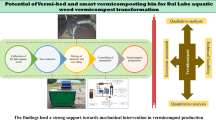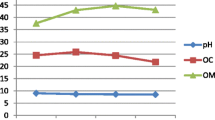Abstract
Purpose
The present investigation was carried out with the assumption that aquatic weed, mostly macrophytes, that is considered as problematic aquatic component can be turned to a money gyrostat through its commercial exploitation that includes composting and pelleting.
Methods
So in present investigation the aquatic problematic macrophytes (APM) were biologically converted to vermicompost and ‘enriched dispersible multipurpose vermipellets’ through vermitechnology.
Results
The ratio (37.5:1) of aquatic problematic weed/macrophytes and pure vermiculture (PVC) for getting higher return (416% for vermipellets and 414% for vermicompost) on investment was standardized. Quality aspects and economic returns from both vermicompost and vermipellets were worked out.
Conclusion
Bioconversion of APM to vermipellets gave more return on per unit investment. The quality (that includes- C/N ratio, weed and disease resistant, nutrient composition and dispersible nature) of the vermipellets were better in comparison to vermicompost. The empirical models for predicting C/N ratio on the basis of quantity of APM for both vermicompost and vermipellets have been developed exclusively.
Graphic Abstract






Similar content being viewed by others
References
Ganie, S.A., Rabani, M.S., Mir, M.A., Khan, I.A.: Proximate nutrient content analysis of some aquatic weeds of Dal lake Srinagar. Int. J. Pharm. Biol. Sci. 9(2), 713–720 (2019)
Lembi, C.A.: Aquatic plant management. Purdue extention, botany and pathology, 1–16 https://ucanr.edu/sites/csnce/files/57550.pdf (2003). Accessed 10 Aug 2020
Gettys, L.A.: Aquatic weed management: control methods 360. SRAC Publication, Stoneville (2014)
Suthar, S., Singh, S.: Vermicomposting of domestic waste by using two epigeic earthworm (Perionyx excavates and Perionyx sansibaricus). Int. J. Environ. Sci. Technol. 5(1), 99–106 (2008)
Shrimal, S., Khwairakpam, M.: Effect of CN ratio on vermicomposting of vegetable wastes. Dynamic soil, Dynamic plant 4 (Special Issue) 1, 123–126 (2010)
Lee, L.H., Wu, T.Y., Shak, K.P.Y., Lim, S.L., Ng, K.Y., Nguyen, M.N., Teoh, W.H.: Sustainable approach to biotransform industrial sludge into organic fertilizer via vermicomposting: a mini review. J. Chem. Technol. Biotechnol. 93(4), 925–935 (2018)
Abbasi, S.A., Ramasamy, E.V.: Solid waste management with vermitechnology xiv. Discovery Publishing House, New Delhi (2001)
Edwards, C.A., Norman, Q.A., Sherman, R.: Vermiculture technology, earthworms, organic wastes and environmental management 1. CRC Press, Florida (2011)
Lim, S.L., Wu, T.Y., Lim, P.N., Shak, K.P.Y.: The use of vermicompost in organic farming: overview, effects on soil and economics. J. Sci. Food Agric. 95, 1143–1156 (2015)
Yadav, K.D., Tare, V., Ahammed, M.M.: Vermicomposting of source separated human faeces by Eisenia fetida: effect of stocking density on feed consumption rate, growth characterstics and vermicompost production. Waste Manage. 31(6), 1162–1168 (2011)
Ndegwa, P.M., Thompson, S.A.: Effect of CN ratio on vermicomposting of biosolids. Biores. Technol. 75, 7–12 (2000)
Sharma, A., Lal, S., Malik, G., Sharma, O.C., Mir, J.I., Singh, D.B., Raja, W.H., Nabi, S.: Dispersible vermi-pellet preparation from aquatic waste/weed/macrophytes. In: Bulletin on promising technologies in natural resource management for temperate regions vol.1, pp. 6–11. ICAR-CITH Publication, Srinagar (2018)
Varshney, J.G., Kumar, S., Mishra, J.S.: Current status of aquatic weeds and their management in India. Proceedings of TAAL 2007: The 12th World Lake Conference, 1039–1045 (2008)
Murali, M., Neelanarayanan, P.: Determination of mesh size for sieving of vermicompost without cocoons and incubation medium for cocoons produced by three species of earthworms. Electron. J. Environ. Sci. 4, 25–30 (2011)
Subbiah, B.V., Asija, H.L.: A rapid procedure for the estimation of the available nitrogen in soils. Curr. Sci. 25, 259–260 (1956)
Santi, C., Certini, G., D’Acqui, L.P.: Direct determination of organic carbon by dry combustion in soils with carbonates. Commun. Soil Sci. Plant Anal. 37(1–2), 155–162 (2006)
Vorsters, A., Demey, F., Hardouin, J.: Influence of worm density on growth of Eudrilus eugeniae. Tropicultura 15(2), 89–90 (1997)
Sah, D., Debnath, P.: Recycling of organic wastes through earthworms. Krishisewa (2012). http://krishiseva.com/organic-agriculture/81-organic-waste-recycle.html
Lalander, C.A., Komakech, A.J., Vinneras, B.: Vermicomposting as manure management strategy for urban small holder animal farms – Kampala case study. Waste Manage. 39, 96–103 (2015)
Lim, P.N., Wu, T.Y., Sim, E.Y.S., Lim, S.I.: The potential reuse of soyabean husk as feedstock of Eudrilus eugeniae in vermicomposting. J. Sci. Food Agric. 91(14), 2637–2642 (2011)
Tchobanoglous, G., Theisen, H., Vigil, S.: Integrated solid waste management: engineering principles and management issue. Irwin McGraw Hill, Boston (1993)
Senapati, B.K., Dash, M.C., Rane, A.K., Panda, B.K.: Observation on the effects of earthworms in the decomposition process in soil under laboratory conditions. J. Comp. Physiol. 5, 140–142 (1980)
Rostami, R.: Vermicomposting. Integrated waste management, pp. 131–142. In Tech, London, UK (2011)
Bitton, G.: Wastewater microbiology, 3rd edn. In: Mitchell R. (eds.) Wiley Series in Ecological and Applied Microbiology. Wiley, Hoboken, New Jersey 247 (2005)
Edwards, C.A.: The use of earthworms in the breakdown and management of organic wastes. In: Edwards, C.A. (ed.) Earthworm ecology, pp. 327–354. CRC Press, Boca Raton (1998)
Edwards, C.A., Lofty, R.: The biology of earthworms. Chapmann and Hall, London (1977)
Sinha, R.K., Agarwal, S., Chauhan, K., Valani, D.: The wonders of earthworm and its vermicompost in farm production: charles Darwin’s ‘friends of farmers’, with potential to replace destructive chemical fertilizers from agriculture. Agric. Sci. 1, 76–94 (2010)
Mohur, R., Soobhany, N.: Comparison of heavy metals content in compost against vermicompost of organic solid waste: past and present. Resour. Conserv. Recycl. 92, 206–213 (2014)
Mohapatra, D., Mishra, S., Sutar, N.: Banana and its by-product utilisation: an overview. J. Sci. Ind. Res. 69(5), 323–329 (2010)
Katongole, C.B., Bareeba, F.B., Sabiiti, E.N., Ledin, I.: Nutritional characterization of some tropical urban market crop wastes. Anim. Feed Sci. Technol. 142(3–4), 275–291 (2008)
Pattnaik, S., Reddy, M.V.: Nutrient status of vermicompost of urban green waste processed by three earthworm species- Eisenis fetida, Eudrilus eugeniae, and Perionyx excavates. Appl. Environ. Soil Sci. 1, 1–13 (2009)
Manyuchi, M., Phiri, A.P., Muredzi Chirinda, N.: Bioconversion of food wastes into vermicompost and vermiwash. Int. J. Sci. Modern Eng. 1(10), 1–2 (2013)
Nair, J., Vanja, S., Martin, A.: Effect of precomposting on vermicomposting of kitchen waste. Biores. Technol. 97(16), 2091–2095 (2006)
Funding
Not applicable.
Author information
Authors and Affiliations
Contributions
AS, SK and NA designed and carried out the study, AS and SK did the analysis, SUN and DBS carried out microbial analysis and interpretations, SAA carried out microscopic and dispersion studies.
Corresponding author
Ethics declarations
Conflict of interest
The auhors declare that they have no conflict of interest to disclose.
Additional information
Publisher's Note
Springer Nature remains neutral with regard to jurisdictional claims in published maps and institutional affiliations.
Rights and permissions
About this article
Cite this article
Sharma, A., Kumar, S., Ahmed, N. et al. Managing Problematic Aquatic Macrophytes through Vermitechnology- Composting and Pelleting. Waste Biomass Valor 12, 5561–5571 (2021). https://doi.org/10.1007/s12649-021-01380-7
Received:
Accepted:
Published:
Issue Date:
DOI: https://doi.org/10.1007/s12649-021-01380-7




